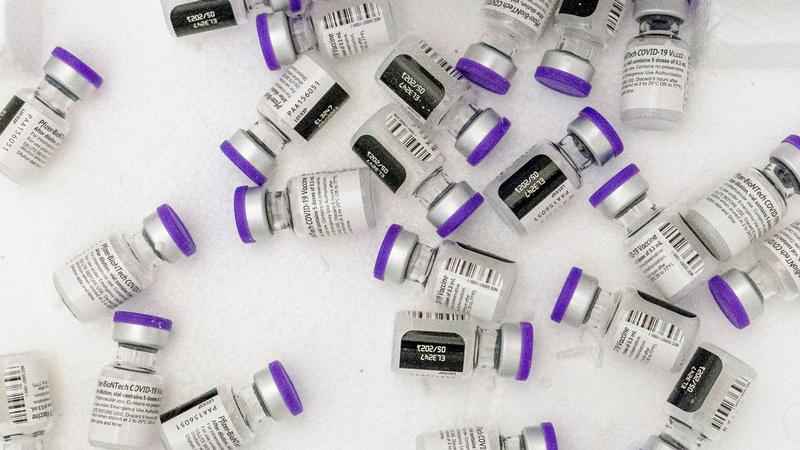MDH prepared to expand COVID-19 vaccine booster eligibility by end of week
[anvplayer video=”5071065″ station=”998122″]
The Minnesota Department of Health is preparing to expand eligibility for COVID-19 booster shots by the end of the week.
During a regular call on Tuesday, MDH Commissioner Jan Malcolm said the state has told federal partners that it will expand booster eligibility for all adults at the end of the week, even if the U.S. Food and Drug Administration or Centers for Disease Control and Prevention hasn’t yet formally approved it.
Malcolm said MDH is concerned enough about the surge of COVID-19 in the state and believes it’s urgent enough to make boosters available to every Minnesotan. She added that MDH does get a sense that federal partners are close to approving booster expansion, anyway.
According to federal action up to this point, there are still some restrictions on who’s been approved for boosters. Starting six months past their last Pfizer or Moderna vaccination, people are urged to get a booster if they’re:
- 65 or older.
- Nursing home residents.
- At least 50 and at increased risk of severe disease because of health problems.
Boosters are also allowed for adults of any age at increased risk of infection because of health problems or their jobs or living conditions. That includes health care workers, teachers and people in jails or homeless shelters.

Vials of the Pfizer-BioNTech COVID-19 vaccine sit in a cooler before being thawed at a pop-up COVID-19 vaccination site in the Bronx borough of New York on Tuesday, Jan. 26, 2021.[AP Photo/Mary Altaffer, File]
It comes as 51 COVID-19 deaths and 10,913 cases were reported by MDH on Tuesday, although those numbers include data from over the weekend.
Hospital capacity has been strained across the state in recent weeks. As of Tuesday, MDH reported 1,348 COVID-19 patients currently hospitalized and 307 in intensive care, numbers not seen since late December 2020. Additionally, only 1% of staffed beds are available in the metro and other portions of the state are in similar spots; only 2% of ICU beds are available in the metro, which is similar to other regions in Minnesota. Also, no pediatric hospital beds are available in the northwest or south-central parts of the state, and no pediatric ICU beds are available in the central region of Minnesota, Malcolm said Tuesday.
The Minnesota Medical Association on Tuesday urged Minnesotans to get vaccinated to help stop the spread of COVID-19, as the state has risen to the top of the nation’s infection rate.
"Seventy percent of the COVID-19 cases admitted to Minnesota hospitals are people who are not vaccinated," MMA President Randy Rice said. "As Thanksgiving approaches, Minnesota physicians are thankful for the availability of safe and effective COVID-19 vaccines. We need more people to recognize this, roll up a sleeve, and give the gift of health to yourself, your family, friends, and community."
Despite the current surge of COVID-19, Malcolm said a peacetime emergency isn’t being considered at this time because, unlike last year, both vaccines and widespread testing are readily available. She added that the state has the tools it needs to battle the COVID-19 surge, Minnesotans just need to use them.
Dr. Ashish Jha, dean of the Brown University School of Public Health, said the urgency now is all about timing.
"The data is now very clear that more than six months out from your second shot, there is a decline in protection against infection, not necessarily against hopitalizations and deaths, but against infections if you want to avoid that," Jha said.
[anvplayer video=”5070987″ station=”998122″]
MDH also talked about the need for mitigation efforts in schools and outbreaks in schools increase.
"We are all beyond tired of this pandemic but it is clearly not even close to over. We must take this pandemic seriously and prioritize our children’s health and education so they can continue in-person learning," Malcolm said.
Malcolm and Dr. Sheldon Berkowitz, president of the Minnesota Chapter of the American Academy of Pediatrics, penned a letter to school officials urging them to follow mitigation strategies and highlighting nine points of mitigation:
- Promote COVID-19 vaccination.
- Encourage universal masking.
- Require social distancing.
- Require students, staff and school officials to stay home when feeling sick (and stay home until negative test results are in).
- Conduct regular testing of unvaccinated students, teachers, staff and those who participate in sports and extracurricular activities.
- Utilize contact tracing and quarantines.
- Improve ventilation efforts.
- Notify officials, students and families of positive cases.
- Utilize additional layers of prevention, such as disinfecting surfaces, regular handwashing, etc.
Implementing those strategies gives schools the best chance for a full year with minimal disruptions, Malcolm said.
MDH Director of Infectious Diseases Kris Ehresmann added that schools without a mask mandate are over three times more likely to have an outbreak than schools with a mask mandate.
"I want to say how much I appreciate all that our students, families, schools, staff and school leaders have done throughout the pandemic. Together, we can keep our schools safe and healthy while keeping our kids in their classrooms, where we know they need to be," Minnesota Department of Education Heather Mueller added.
Mueller also said MDE has mailed letters to every Minnesota family with a school-aged child, reminding of them of the layers of best practices for preventing the spread of the virus that causes COVID-19 in schools.
Additionally, Berkowitz noted data from the American Academy of Pediatrics shows an increase of 122,000 children’s cases of COVID-19 last week alone, which is a 22% increase compared to two weeks ago and the 14th straight week COVID-19 cases have been above 100,000 in children.
[anvplayer video=”5070916″ station=”998122″]